
Alexander Heinle
Alex is a marketer at Zavvy. On this blog, he mainly shares insights gained from discussions with selected experts and from helping our customers set up and improve their onboarding or learning programs.

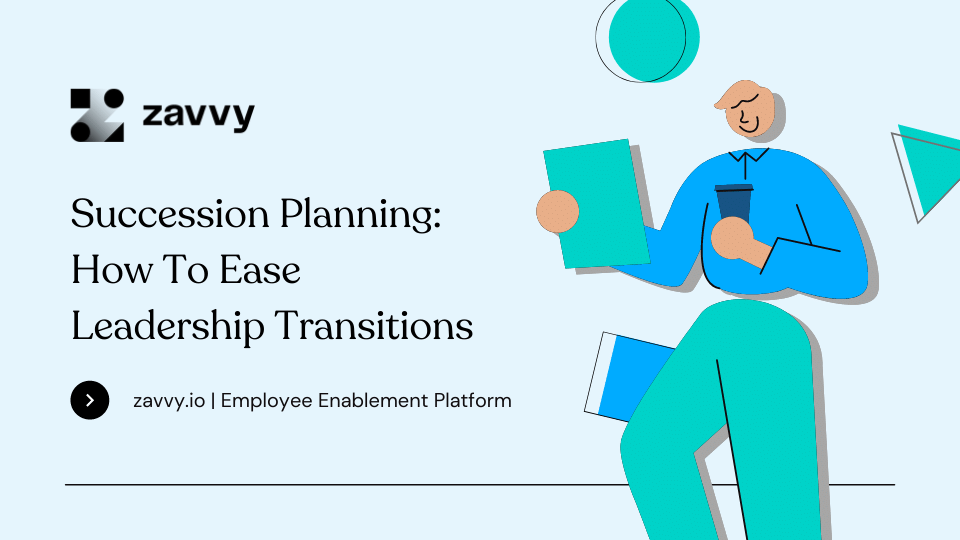
Could your business survive if a wave of senior managers resigned tomorrow? C-suite turnover is a challenge many organizations have faced during The Great Resignation.
But companies that have invested in succession planning have a leadership talent pipeline ready to take the reins.
Together with our curators, we have created a library of actionable digital marketing resources. Personalized to your team's needs.
So, what is succession planning?
This business strategy focuses on identifying and training future leaders. The ultimate goal is a smooth transition during handovers in business-critical roles.
Some of these handovers may occur due to events we can prepare for, such as retirement. Others will be an emergency situation such as the pandemic, illness, or death.
Succession planning ensures high-potential candidates have been identified to step into leadership, managerial, or specialist roles and take on their responsibilities without disrupting the company. And these can be companies of any size.
The end game of succession planning is to replace an outgoing employee who has held a key position at your company. But why is this important?
"94% of employees stay longer at a company if it invests in their growth."
Succession planning is important because it:
"While succession planning may seem like a daunting task, it is essential for organizations to invest the time and resources necessary to ensure a smooth transition of leadership."
- Max Benz, Founder, and CEO of BankingGeek
But who should take charge of succession planning? In many cases, Human Resources are best placed to lead the process as they're involved in recruitment, employee development, and talent reviews. HR also has an excellent overview of the company and communicates with department heads to create and monitor succession planning frameworks.
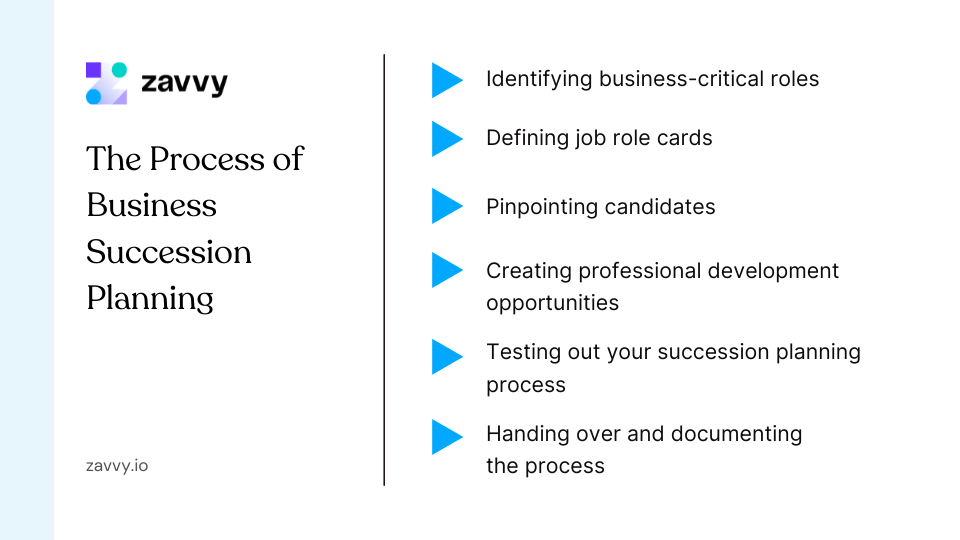
It's not a quick process, though – succession planning can often take between one to five years before a candidate is ready to move into a role. The stages of the process include:
Which are the key roles that are essential to your business? Naturally, you might look towards the top of your organization at your CEO, CFO, and COO, but don't rule out lower-management roles. If there's a product specialist or technical expert your company couldn't operate without, they require a succession plan too.
It's also worth researching market trends to identify which jobs may be at risk. For example, if you have a talented employee working in a position that your competitors struggle to recruit for, they may be targeted.
Focus on roles, responsibilities, and relationships more than a specific job title. For example, if an employee has worked with your company for many years and has developed crucial business relationships, this could be a painful departure.
"What if you have a key team that's going to give a major presentation, and you've got no backup plan? And now someone comes down with Covid or has exposed the whole team to it. Who's going to step in?"
- Trish McFarlane, CEO and Principal Analyst, H3 HR Advisors
If you don't have current job or leadership roles documented, succession planning is an opportunity to flesh out a template for each position you may need to fill in the future. This involves:
Your role cards can also cover the competencies required for the position. These can be categorized as:
Identifying suitable successors for the positions you need to fill is the next step – and internal and external candidates may both be considered.
When looking internally, the successor doesn't need to be the next person in line, according to your company's organizational chart.
The skills and competencies defined in your job profiles can come from further down your ranks.
In fact, leapfrog CEOs (those promoted from below the second layer of management) are more likely to perform better than former CFO, COO, or DCEOs who subsequently arrive at the top job.
HR can also assist in the process of identifying external successors during recruitment. But in both internal and external scenarios, it's critical to speak informally with high-performing candidates about their vision of a professional future with your company. Remember, their individual career goals may not always align with the company's long-term goals.
Employee growth and development should be a core part of your company culture, and its integration with workforce planning takes on even greater meaning.
Professional development programs for successor candidates may include:
Instead of waiting for a crisis to strike, there are natural opportunities for your internal successor candidates to take on greater responsibilities before a promotion. If their manager is on vacation or sick leave, your successor can temporarily move into a leadership position.
This trial run will demonstrate the experience they've already gained while highlighting areas of employee development requiring more focus.
"Giving a succession candidate more responsibilities over time can serve as a form of executive prep. It will provide for a smoother and more seamless transition process when the appropriate time presents itself."
- Ramcess Jean-Louis, global head of diversity and inclusion at Verizon Media.
The final stage of any succession planning is to appoint a successor formally, set up a handover period, and announce the news to your workforce and clients. Ideally, this will be a successful transition, but you can document the following to ensure an effective succession plan for future appointments. This can include:
There are some best practices to bear in mind when following the steps above.
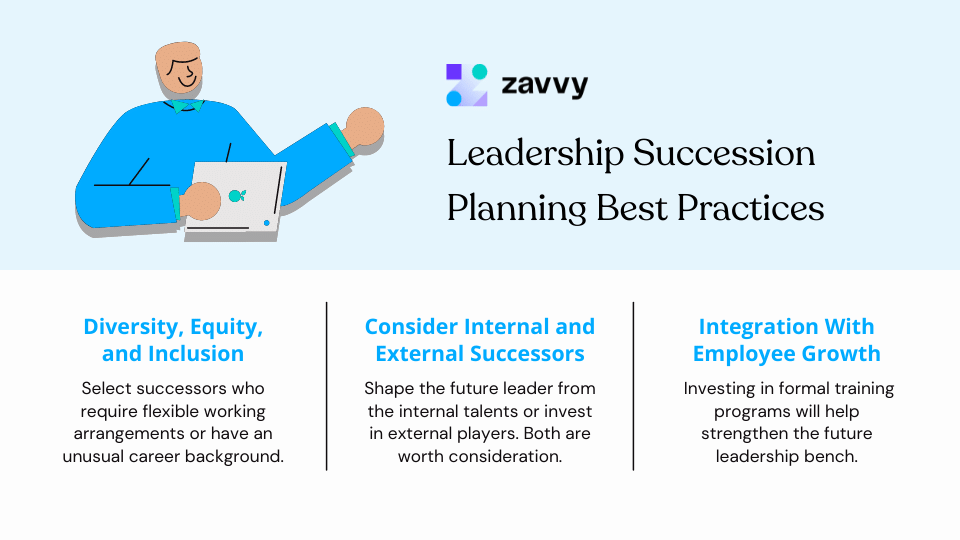
DEI is a hot topic and should be considered when developing your leadership pipeline. In 2021, there were only 41 female Fortune 500 CEOs, including two black women.
Incorporating inclusion and diversity into your planning could mean selecting successors who require flexible working arrangements or have an unusual career background.
Your talent management should focus on what they can bring to the role in the future, not what has been missing in their past.
So, should you be appointing successors from an internal pool of candidates or by looking outside your organization? Both are worth consideration.
Promoting from within allows you to nurture internal talent and shape future business leaders. Create a pool of high-potential internal candidates based on their competency profiles or take a skills-based approach to employee growth. Focusing on internal promotions is also a great way to improve retention rates as employees want to work for organizations that are invested in their future.
Although 77% of S&P 500 CEOs hand over to internal successors, many business-critical roles can be filled by experienced successors from outside too. So keep a close eye on external talent in the wider industry to approach if you have a vacancy.
Succession planning must be heavily intertwined with employee growth and development. By doing so, HR departments can develop an agile workforce equipped with skills that can translate across multiple departments. Allowing potential successors to work laterally on secondments, and investing in formal training programs, will help to strengthen the future leadership bench.
"The thing that's really interesting is the idea of job adjacency. Instead of constantly being on one track, nowadays you have so many people who want to experience lots of different areas of the organization before they lock into one path."
- Tara O'Sullivan, CMO at Skillsoft
So which organizations have committed to succession planning? We've picked out five examples of how successful companies have found their new leaders.

Daniella Vitale became CEO of retailer Barneys New York in 2017, taking over from Mark Lee. Before joining Barneys as a Chief Merchant, Vitale worked her way through a series of lateral moves at fashion brands, including Gucci, Armani, and Ferragamo. As CEO of Barneys, Lee invested in Vitale's future by creating a five-year succession plan including multiple leadership opportunities.
In her position as COO, she had experienced leadership in almost every business area before becoming CEO herself. Mark Lee's announcement read,
"It's time to turn the day-to-day management over to Daniella, who has long been my planned successor and is uniquely qualified to take the leadership reins."

Ginni Rometty had been IBM's CEO since 2012 until the announcement in early 2020 that she would be handing over the role to her successor Arvind Krishna. As a technical expert with 30 years at IBM, Krishna is widely respected across the company and held the position of Senior Vice President of Cloud and Cognitive Software until his promotion.
This CEO transition has been a year-long planning process by the IBM board, with Rometty heavily involved in the succession.

In 2021, the founding CEO of Amazon, Jeff Bezos, handed over the role to his successor. Before stepping up, Andy Jassy had been the CEO of Amazon Web Services since 2003, leading AWS to control a third of the total cloud computing market.
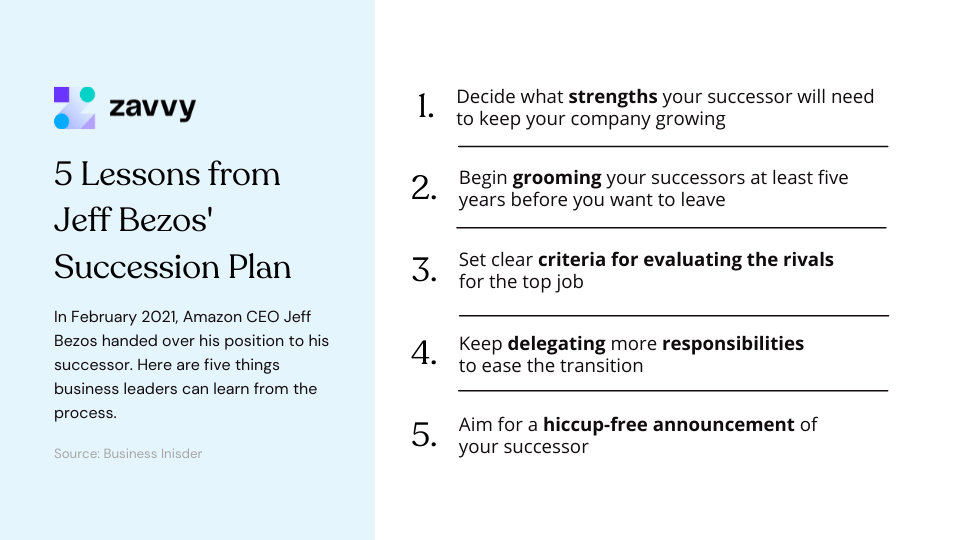
This succession plan had been in the works for several years, with Bezos stating in 2014,
"As the company has grown, my job has changed very much. I'm not going to be here forever."
Amazon has a succession plan for all the senior executives at the company. The strategy includes an annual review of the top executive team's future plans and backup candidates and a chart that maps out the company's rising stars. Constant communication between each executive and a selected two or three direct reports ensures consistency in the case of an unexpected structural change.

Apple has its own signature training ground, established in 2008 by Steve Job as the Apple University. Although they keep their facility and courses secret, the idea is to educate internal employees about the history and goals of the company to find the next generation of talent to continue the legacy.
Current Apple CEO Tim Cook is an instructor at Apple University. He says,
"I see my role as CEO [is] to prepare as many people as I can to be CEO."

In 2013, Steve Ballmer made the surprise announcement that he would be stepping down as Microsoft's CEO. But without a succession plan in place, the company turned to external recruitment to identify an appropriate person for the job. A search committee headhunted over 100 candidates and shortlisted 20 of them, including Steve Mollenkopf, who became CEO of Qualcomm instead, and Alan Mulally, who pulled out of the race.
After six months without a viable successor, Microsoft turned its attention to an insider, Satya Nadella, to become its third-ever CEO. Microsoft ultimately made a fantastic decision, with the stock rising 30% during the first nine months of Nadella at the helm. But this was an uncertain period in the company's history that could have been alleviated with a formal succession plan.
Unfortunately, as was the case with Microsoft, it's not unusual for companies to lack a succession strategy. This was highlighted by an HBR study during the 2020 pandemic, with some countries worse at focusing on CEO succession than others.
For example, 83% of companies across Spain and 78% in both Italy and China did not have a contingency plan for CEO succession. This compares to
A closer look at different industry types reveals that media companies and those selling leisure products are the least likely to have invested in succession planning.
Now that you understand the importance of succession planning and how it works, it's time to create your succession planning model. The process can be broken down into four main phases.
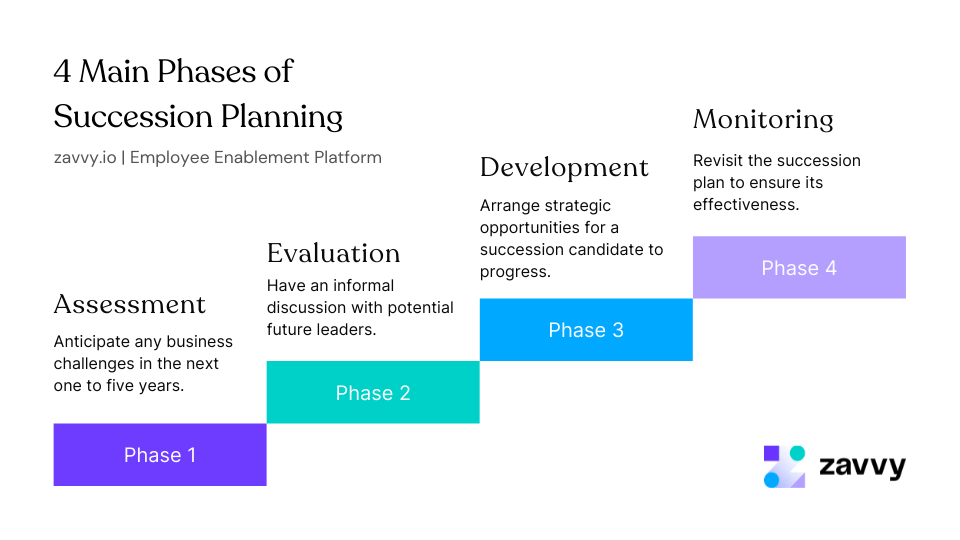
During this phase, you'll anticipate any business challenges you may encounter in the next one to five years. This might include:
You'll also identify the roles most crucial to business continuity and the skills and competencies required for success in these positions.
During the evaluation stage, you'll consider high potential employees and have an informal discussion to assess their interest in being developed as future leaders. It's critical to stress that there are no guarantees of promotion, and there may be multiple succession candidates in the mix.
The developmental phase is ongoing and relies on HR managers to arrange strategic opportunities for a succession candidate to progress. The best approach is to have a talent pool developing simultaneously. This allows you to compare performance and ensure a strong pipeline of candidates ready to step up when the time comes.
Succession planning is not a set it and forget it strategy. Although it's an intensive process, it should be revisited periodically to check that it aligns with your company's goals and objectives.
Your monitoring should include:
Use a simple template to document your succession planning overview and stay organized.

The template offers a status overview of your current succession plans. It tracks the vulnerable position you need to provide a talent pipeline for - along with an expected date for the departing employee.
Provide a rating for each of your potential successors. This is a readiness measurement for when a succession candidate may be ready to take over a key employee role. For example, a younger employee with less experience might have a lower rating. In contrast, a more seasoned member of your team who has worked across several business areas might have an indicator score of 8 or 9.
This template is designed as an overview to share with your board or within your HR department. It can link to a different succession plan for each individual candidate detailing their ongoing career development framework.
➡️ To use our spreadsheet template, simply click on this link and make a copy
Leadership planning can be challenging, which is why you need the right tools to direct your strategy. Consider some of the following:
Zavvy's employee growth solutions encourage a social buzz and culture throughout the development phase of your succession planning strategy. After defining role cards and assigning these to employees, managers can also motivate team members to improve their performance using customized employee growth plans.
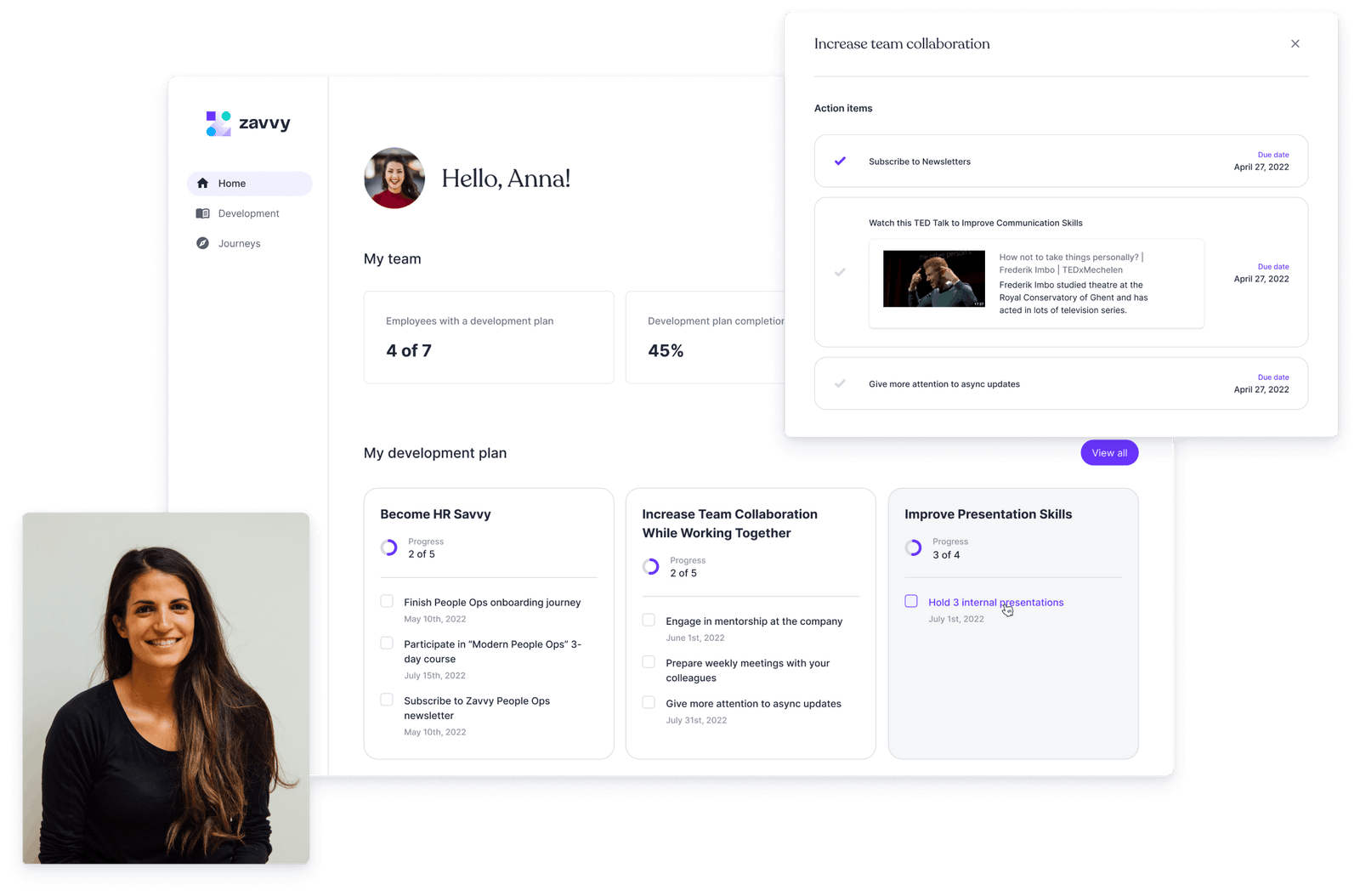
With a combination of managerial input, smart notifications, and Zavvy guides, employees feel empowered to grow and move toward the leadership position they've been lined up for.
Personality assessments are common when recruiting for leadership positions, as traits including enthusiasm and commitment are essential. Another soft skill to assess is behavior - understanding how a candidate will react socially and professionally to a given situation can clarify whether they're an appropriate successor.
Cognitive tests can also form part of your candidate identification process to help you find potential successors with the necessary range of critical thinking and reasoning logic skills. If you're creating a succession strategy for a key technical role, use an in-depth technical assessment to provide detailed insights about suitability.
Successors must be lined up to fill business-critical roles in your organization and secure your company's future. But successful succession planning isn't an overnight process - it requires assessments, evaluation, and regular monitoring of your candidate's growth and development.
You can't grow your business without growing your people. So, create a continuous development cycle and unlock your succession process by arranging a demo of Zavvy's employee growth software.
Upskill your team every week with the best contents and personalized recommendations.

Could your business survive if a wave of senior managers resigned tomorrow? C-suite turnover is a challenge many organizations have faced during The Great Resignation.
But companies that have invested in succession planning have a leadership talent pipeline ready to take the reins.
Get a demo!
We'll be happy to show you around and answer all your questions.
Trusted by innovative companies



We'll be happy to show you around, answer your questions, or arrange a free trial.
Erhalten Sie eine kostenlose Demo unserer Onboarding-Software.
Vertraut von



Your Training & Development Strategy - Solved in 1 Tool.
Trusted by innovative companies



We'll be happy to show you around, answer your questions, or arrange a free trial.
Learn how Zavvy helps you drive performance, development, and engagement.
Trusted by innovative companies



We'll be happy to show you around, answer your questions, or arrange a free trial.
We'll be happy to show you around and answer all your questions.
Trusted by innovative companies



We'll be happy to show you around, answer your questions, or arrange a free trial.
Gerne zeigen wir Ihnen ganz unverbindlich unsere Plattform im Detail.
Vertraut von modernen Unternehmen



Get a demo!
We'll be happy to show you around and answer all your questions.
Trusted by innovative companies



We'll be happy to show you around, answer your questions, or arrange a free trial.
Erhalten Sie eine kostenlose Demo unserer Software für Mitarbeiterenwicklung und Training.
Moderne Unternehmen
setzen auf Zavvy


